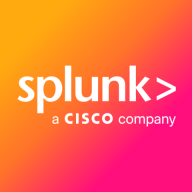

Splunk Enterprise Security and Seceon Open Threat Management Platform compete in the domain of threat management and security analytics. Splunk generally leads in popularity and community support, while Seceon stands out with its comprehensive set of features centered around AI and automation.
Features: Splunk Enterprise Security is renowned for its robust search capabilities, real-time threat detection, and extensive third-party integrations. Additionally, it offers features such as Mission Control for streamlined alert management. Seceon Open Threat Management Platform focuses on automated threat detection and response using machine learning and AI, offers real-time response capabilities, and robust endpoint security.
Room for Improvement: Splunk's initial setup process could be simplified, and its deployment efficiency improved. It would also benefit from more streamlined data management and an upgraded alerting system to reduce noise. Seceon could enhance its third-party integration capabilities and bolster its documentation and community resources. Improvements in user interface customization and real-time query capabilities would also enhance its user experience.
Ease of Deployment and Customer Service: Splunk comes with a complex initial setup, supported by a strong community and extensive documentation, which can be resource-intensive for new users. In contrast, Seceon offers a more streamlined deployment process with minimal configuration needs and efficient customer service, making it user-friendly and quick to deploy.
Pricing and ROI: Splunk typically involves higher initial costs, but its comprehensive features ensure long-term ROI. Seceon, on the other hand, offers cost-effective pricing options with quicker time to value and lower upfront investment, making it attractive to organizations prioritizing cost efficiency without compromising essential functionalities.
| Product | Market Share (%) |
|---|---|
| Splunk Enterprise Security | 7.4% |
| Seceon Open Threat Management Platform | 0.8% |
| Other | 91.8% |

| Company Size | Count |
|---|---|
| Small Business | 8 |
| Midsize Enterprise | 5 |
| Large Enterprise | 1 |
| Company Size | Count |
|---|---|
| Small Business | 109 |
| Midsize Enterprise | 50 |
| Large Enterprise | 263 |
Seceon Open Threat Management Platform is a comprehensive cybersecurity solution that offers real-time threat detection, analysis, and response capabilities. It leverages advanced AI and machine learning algorithms to provide proactive threat hunting and automated incident response.
With its intuitive dashboard, users can gain complete visibility into their network, applications, and endpoints, enabling them to identify and mitigate potential risks effectively. The platform integrates seamlessly with existing security infrastructure, consolidating data from various sources for centralized monitoring and analysis.
Its threat intelligence feeds and behavioral analytics enable the identification of both known and unknown threats, ensuring comprehensive protection against advanced cyber attacks. Seceon Open Threat Management Platform empowers security teams with actionable insights, enabling them to prioritize and respond to threats swiftly. With its automated remediation capabilities, it minimizes the impact of attacks and reduces response time. The platform also offers customizable reporting and compliance management features, facilitating regulatory compliance and providing stakeholders with comprehensive security status updates.
Seceon Open Threat Management Platform is a robust and scalable solution that caters to the evolving cybersecurity needs of organizations across industries.
Splunk Enterprise Security delivers powerful log management, rapid searches, and intuitive dashboards, enhancing real-time analytics and security measures. Its advanced machine learning and wide system compatibility streamline threat detection and incident response across diverse IT environments.
Splunk Enterprise Security stands out in security operations with robust features like comprehensive threat intelligence and seamless data integration. Its real-time analytics and customizable queries enable proactive threat analysis and efficient incident response. Integration with multiple third-party feeds allows detailed threat correlation and streamlined data visualization. Users find the intuitive UI and broad compatibility support efficient threat detection while reducing false positives. Despite its strengths, areas such as visualization capabilities and integration processes with cloud environments need enhancement. Users face a high learning curve, and improvements in automation, AI, documentation, and training are desired to maximize its potential.
What Are the Key Features of Splunk Enterprise Security?In specific industries like finance and healthcare, Splunk Enterprise Security is instrumental for log aggregation, SIEM functionalities, and compliance monitoring. Companies leverage its capabilities for proactive threat analysis and response, ensuring comprehensive security monitoring and integration with various tools for heightened operational intelligence.
We monitor all Security Information and Event Management (SIEM) reviews to prevent fraudulent reviews and keep review quality high. We do not post reviews by company employees or direct competitors. We validate each review for authenticity via cross-reference with LinkedIn, and personal follow-up with the reviewer when necessary.